NVIDIA's GeForce 8800 (G80): GPUs Re-architected for DirectX 10
by Anand Lal Shimpi & Derek Wilson on November 8, 2006 6:01 PM EST- Posted in
- GPUs
The 680i Platform
Alongside the GeForce 8800 GTX and GTS, NVIDIA is launching a brand new chipset for Intel processors, the nForce 680i (and 650i SLI and Ultra). Our own Wesley Fink has published an in-depth look at the new chipset, but we felt the release significant enough to comment on some of its features here in this review.
For the most part, competing with Intel for its chipset business is an effort in futility. The companies that have tried have ended up either segregated to the low end of the market or kept to an extremely small niche. The past has proven that it is simply very difficult for a company that isn't Intel to produce a better performing chipset for Intel processors.
The multi-GPU era has changed things a bit, because now all of the sudden there's a new feature that Intel can't simply support on its chipsets. It took a while but ATI eventually allowed Intel to support CrossFire on its chipsets, but who knows how long that will last given ATI's new owner. While ATI caved in and supported Intel, NVIDIA would not capitulate. NVIDIA is like a mini-Intel and just like the big version, it doesn't play well with others. Licensing SLI for use on Intel chipsets was simply not in the cards; instead NVIDIA used SLI support as a reason for Intel users to consider NVIDIA chipsets. As NVIDIA continues to have the stronger multi-GPU lineup (although ATI has recently started fixing some of its problems with CrossFire), the SLI brand remains strong.
Although behaving like a veteran chipset manufacturer, NVIDIA is still a relative newcomer to the chipset business, but one thing we have seen from the boys in green is that they definitely learn from their mistakes. Dating back to the original nForce chipset, NVIDIA fell flat on its face with its first attempt at PC core logic, but bounced back to topple VIA with its nForce2 chipset. And it's that nForce to nForce2 transition that we're seeing here again with NVIDIA's nForce 680i SLI.
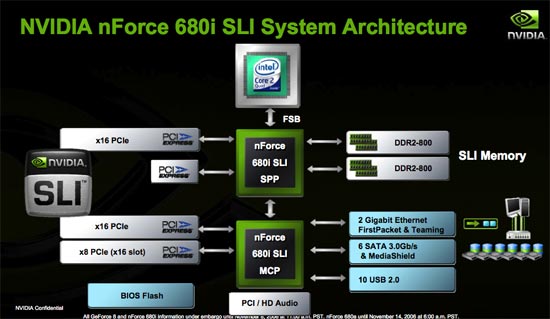
The 680i SLI is strictly a high end chipset, as the lower end of the market will still be serviced by NVIDIA's 570 SLI. The 680i supports all of the checkbox features: 1066MHz FSB (with unofficial support for higher speeds), dual channel DDR2-800, two PCIe x16 slots, one PCIe x8, 2 GbE ports, 6 SATA, 10 USB and HD Audio.
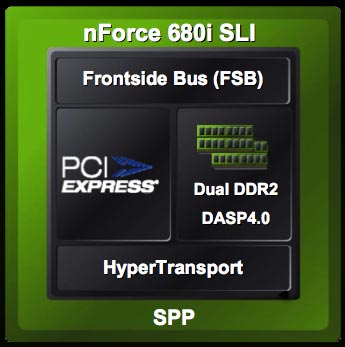
There are some pretty unique features about the new chipset. For starters it is the first NVIDIA core logic to be built on a 90nm process. The 680i SPP (aka North Bridge) is built on TSMC's 90nm process and thus ends up running cooler and can be overclocked more than NVIDIA's previous offerings in the area. The South Bridge (680i MCP) is still a 130nm chip but its functions are far less critical than those of the North Bridge.
In the 680i SPP is an updated version of NVIDIA's pre-fetching core called DASP. The major change to the 680i's DASP is that it is optimized for the memory access patterns of Conroe and Kentsfield which apparently are very different from NetBurst CPUs of the past. Given the aggressive prefetching done by the new Core processors and the large shared L2 cache, it isn't surprising to find out that memory controllers tuned to older Intel processors might not be best optimized for Core.
The primary function of the 680i's DASP is to examine memory access patterns and prefetch data into a local buffer that it thinks the processor will need at a later point in time. The updated version of DASP prefetches one cache line (64B) at a time into an internal buffer, although NVIDIA wouldn't disclose the size of the buffer.
We couldn't get much more information on DASP 4.0 from NVIDIA other than it supports prioritizing of reads over writes (to avoid read-to-write delays from random memory requests) and that a number of proprietary algorithms are used to make sure that prefetching doesn't occur when the CPU actually needs data from the memory controller.
Overclocking is a very large part of the new 680i chipset, and Wes' review of it goes into great detail about what exactly is possible with this new platform. For us, the other interesting part of the 680i platform is that, for the first time, NVIDIA is allowing its partners to sell NVIDIA engineered and designed 680i motherboards.
It has often been the case that a chipset maker's reference board has far more bells and whistles than anything its motherboard partners actually sell on the market. NVIDIA was growing weary of this being the case and instead effectively engineered a reference board that could be sold in retail.
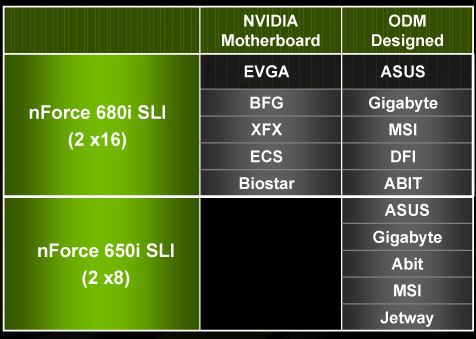
Motherboard makers can still choose to design their own 680i boards, but some have opted to simply rebrand NVIDIA's design.
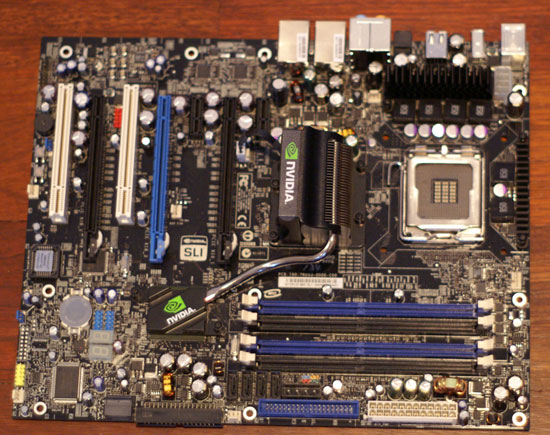
We ran all of our tests for this review on NVIDIA's nForce 680i SLI motherboard; this particular one is branded by EVGA. We were extremely pleased with the stability, BIOS, attention to detail and overall performance of the 680i solution. The decision to introduce NVIDIA designed 680i boards also shows how far NVIDIA has come as a manufacturer; if you want something done right, you sometimes have to do it yourself, and that's exactly what NVIDIA decided to do here. Honestly, the only downside is its estimated cost of $229.
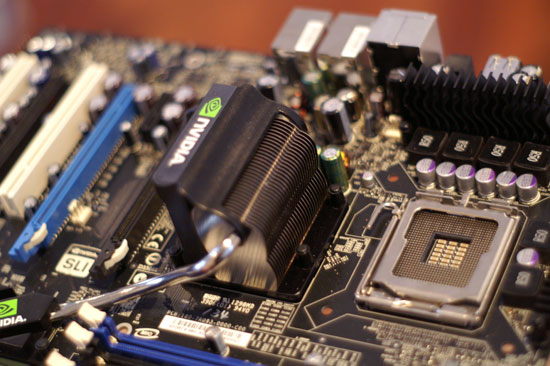
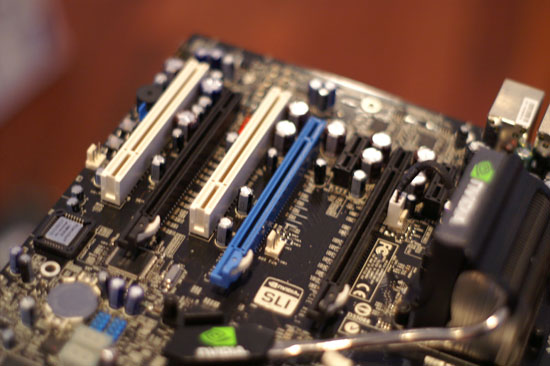
Three PCIe x16 slots (one is an x8 electrical)
NVIDIA is also introducing a lower cost 650i SLI chipset with only two x8 PCIe slots, but there will be no NVIDIA engineered boards available based on that chipset.










111 Comments
View All Comments
DerekWilson - Thursday, November 9, 2006 - link
i'm sure there was a lot burried in there ... sorry if it wasn't easy to find.8800 gtx and gtx are both no louder than 7900 gtx. 1950 xtx still takes the cake for loudest graphics card around by a long shot -- especially after it heats up in a game.
crystal clear - Thursday, November 9, 2006 - link
My comments in Daily Tech on this subject-More "G80" Derivatives in February R
E: More info would be nice
By crystal clear on 11/8/06, Rating: 2
By crystal clear on 11/8/2006 8:03:43 AM , Rating: 2
If you link VISTA -SANTA ROSA platform-Core2DUO(merom)CPU line up(T7300,7500,7700 models)then a matching Graphics card
to complete the link.
So a G80 for laptops/notebooks?
The pairing of Intels Santa Rosa platform with Vista in the 2Q 07 is next big thing for the first tier notebook manufacturers & all they need is a matching G80 for this setup.
Unquote-
Nvidia currently caters to Desktop requirement/needs with the new G80 releases,wonder how the notebook/server versions will be-with Vista ofcourse.
yyrkoon - Thursday, November 9, 2006 - link
Vitual memory is probably a good thing for most cases, but in the graphics arena, this *could* potentially make for sloppy/ bad coding practises. Knowing a lot of game devers (some of which actually work for well known companies), I've heard them from time to time complain about maxing a 16x PCI-E pipe. What I'm trying to say here, is that while it would be a good thing for never having to run out of texture memory, but that system memory, and definately the swap disk can not hold a candle to the memory bandwidth that most Video cards are capable of. End result, is that you definately *will* get a performance hit. All this, and we already know the memory bandwidth capabilities of modern PCs, suffice it to say, the most we'll see from current systems is what ? 12-13K GB/s ? Even a 7800GS can do roughly 35 GB/s on card. A 7600GT ? 22GB/s ?Still I think Directx10 is a very good thing, and as I didnt read the whole article, perhaps a missed a little ? Reason being, I've been reading about Directx10 since April, and a friend of mine was privy to some of this information after an interview with ATI.
http://www.gamedev.net/reference/programming/featu...">http://www.gamedev.net/reference/programming/featu...
saratoga - Thursday, November 9, 2006 - link
I don't know how they threading really works, but its quite possible VM support is required in order to allow multiple threads to run without stepping all over each other,.saratoga - Thursday, November 9, 2006 - link
Sorry, should read "I don't know how THEIR threading works"falc0ne - Thursday, November 9, 2006 - link
I don't know what is the problem but I'm really unable to see the images within the latest articles from Anand...Can anyone give me a suggestion? What might be the cause of that?The thing is I'm really, really interested in these articles and I need to see those images. Thanks
yyrkoon - Thursday, November 9, 2006 - link
Oh, er, then in the options tab of Firefox, (tools->options->content) check the "load images" check box ;)falc0ne - Thursday, November 9, 2006 - link
well...it would've been simple but I'm afraid is not that...It might be the addblock extension from firefox, other than that I have nooo ideeea...Well I will use the IE tab option instead and load the pages using IE 7. Thanks anyway:)yyrkoon - Thursday, November 9, 2006 - link
Checked the exceptions list ? I know that firefox makes it really simple to block images from a site (to a point of being too easy).JarredWalton - Thursday, November 9, 2006 - link
If you've got AdBlock on Firefox, press Ctrl+Shift+A and you can see what it's blocking. If it blocks the images.anandtech.com stuff, you can then see which RegEx isn't working right and edit that.